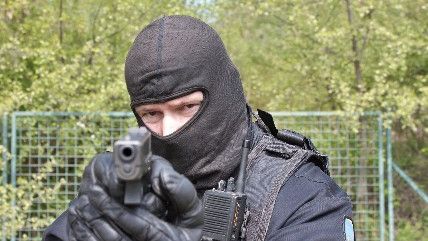A New Model for a Police Shooting Database?
Researchers in St. Louis broaden analysis of police force beyond just fatalities.

The lack of a federal government database to record and analyze deadly

interactions between law enforcement and the citizenry, described as "embarrassing and ridiculous" by FBI Director James Comey earlier this year, has led to journalists and citizen volunteers setting up their own databases to keep the public informed of the number of people killed each year by police.
Last week, Reason noted that the one thousandth fatality at the hands of US police in the year 2015 had been confirmed by The Guardian. Two independent websites, Fatal Encounters and Killed By Police, put the number at slightly over 1,000. But a new model for analyzing police shooting data could be emerging out of St. Louis.
David Klinger, a former police officer who wrote of his experience having killed someone in the book Into the Kill Zone: A Cop's Eye View of Deadly Force, has devoted his post-law enforcement career in academia to studying and analyzing deadly force. He and 3 University of Missouri-St. Louis colleagues have authored a study that will be published in an upcoming issue of the Journal of Criminology and Public Policy, which analyzes 230 shootings by police in St. Louis from 2003-2012.
According to the St. Louis Post-Dispatch, "the study's methodology mines layers of information not broadly available" including some relatively surprising details such as "St. Louis officers missed the people they were shooting at in half the encounters" and "police shootings here were not necessarily associated with the most violent areas, or the prevailing race of the neighborhood."
The Dispatch reports:
With no official national tally, recent news media efforts have tried to collect police shooting data. But they have been focused solely on fatalities — a relatively rare outcome that does not provide an accurate picture of the issue, the criminologists said.
Focusing only on deaths effectively looks at marksmanship, Klinger noted, as one department might fire more often than another one that kills more people.
Knowing more, police might find that one type of weapon or ammunition is more effective than another. Or whether the race of an officer and target plays a role. Or whether recruits from a particular academy class shoot more often.
"Our hope is to get other agencies around the country to participate as well, so we can get insight into the very important question on whether what we found in St. Louis is happening around the country," Klinger said. "We offer cogent argument about why this may be, but it might be different in other places."
For his part, the ex-cop turned academic Klinger has always asserted that he's no cop-basher, but he believes increased transparency will help police relations with the community and improve the public's view of law enforcement. Some of the data he and his colleagues have dug up backs the assertions of many police advocates that officers only deploy deadly force when absolutely necessary:
At least one suspect had a gun in 79 percent of (shootings)…
Most, possibly all, of those killed were armed, the report shows. In four instances, it says, the reports left it unclear. Twenty-nine had guns, and 14 of them fired at police. The others were listed with weapons that included knives, other edged weapons, a car, and a bat or brick.
It will be interesting to see what kind of impact the report has on a national scale. Now that there's a widespread awareness that the government lacks even the basic data to analyze the use of deadly force, the next step is to move past raw numbers and begin the process of understanding why police resort to deadly force. Granted, what happens in St. Louis may not directly correlate to Los Angeles, New York or Baltimore, but as a major city with no shortage of tension between police and the community, it's a reasonable barometer to begin a more substantive conversation.


Show Comments (8)